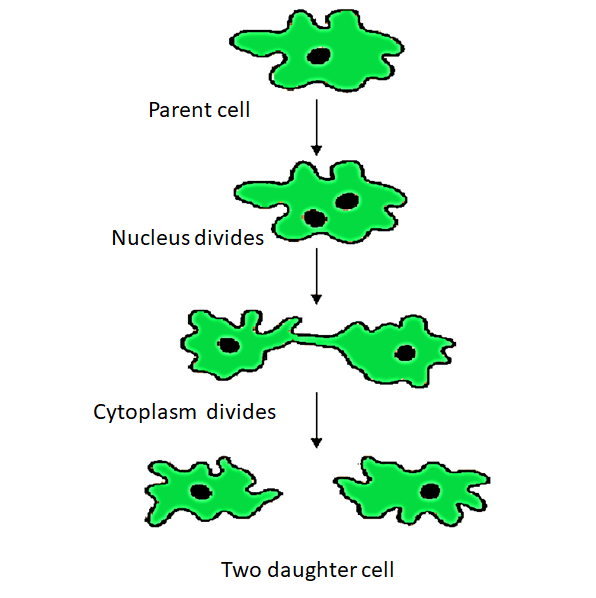
The process of asexual reproduction in amoeba is
(a) Binary fission
(b) Budding
(c) Vegetative reproduction
(d) Spore formation
Answer
576.6k+ views
Hint:Amoeba divides into two halves to form two daughter cells. In the process of asexual reproduction through which amoeba reproduces parent itself is a reproductive unit and continues to live as two daughter individuals.
Complete answer:
Amoeba reproduces asexually by the process called binary fission. Binary fission occurs in single- celled organisms belonging to Kingdom Monera, and Protista (Amoeba and paramecium). In this process, the parent organism divides into two halves, each half forming an independent daughter organism. It means the parent body as a whole form the reproductive unit, and the parent continues living as two daughter individuals.
Depending on the plane of division, binary fission is of the following types: Simple binary fission: Also known as irregular binary fission. A division can occur through any plane. For example Amoeba. Longitudinal Binary Fission: The plane of division passes along the longitudinal axis of the organism. Example, Euglena Transverse Binary division: The plane of this division runs along the transverse axis of the individual, for example, Bacteria, Paramoecium, Diatoms.

So, the answer is, ‘Binary fission’.
Note: - In binary fission cell division itself is a mode of reproduction. - It involves amitosis in bacteria and mitotic division of the nucleus in yeast and amoeba i.e.,
karyokinesis (a division of the cytoplasm) followed by cytokinesis (a division of the nucleus). - The parent cell in binary fission disappears. - Protuberance like in budding is absent in binary fission. - There is no change in the Chromosome Number of the daughter cells. - Organelles like Mitochondria also divide through binary fission.
Complete answer:
Amoeba reproduces asexually by the process called binary fission. Binary fission occurs in single- celled organisms belonging to Kingdom Monera, and Protista (Amoeba and paramecium). In this process, the parent organism divides into two halves, each half forming an independent daughter organism. It means the parent body as a whole form the reproductive unit, and the parent continues living as two daughter individuals.
Depending on the plane of division, binary fission is of the following types: Simple binary fission: Also known as irregular binary fission. A division can occur through any plane. For example Amoeba. Longitudinal Binary Fission: The plane of division passes along the longitudinal axis of the organism. Example, Euglena Transverse Binary division: The plane of this division runs along the transverse axis of the individual, for example, Bacteria, Paramoecium, Diatoms.

So, the answer is, ‘Binary fission’.
Note: - In binary fission cell division itself is a mode of reproduction. - It involves amitosis in bacteria and mitotic division of the nucleus in yeast and amoeba i.e.,
karyokinesis (a division of the cytoplasm) followed by cytokinesis (a division of the nucleus). - The parent cell in binary fission disappears. - Protuberance like in budding is absent in binary fission. - There is no change in the Chromosome Number of the daughter cells. - Organelles like Mitochondria also divide through binary fission.
Recently Updated Pages
Why are manures considered better than fertilizers class 11 biology CBSE

Find the coordinates of the midpoint of the line segment class 11 maths CBSE

Distinguish between static friction limiting friction class 11 physics CBSE

The Chairman of the constituent Assembly was A Jawaharlal class 11 social science CBSE

The first National Commission on Labour NCL submitted class 11 social science CBSE

Number of all subshell of n + l 7 is A 4 B 5 C 6 D class 11 chemistry CBSE

Trending doubts
What is meant by exothermic and endothermic reactions class 11 chemistry CBSE

10 examples of friction in our daily life

One Metric ton is equal to kg A 10000 B 1000 C 100 class 11 physics CBSE

1 Quintal is equal to a 110 kg b 10 kg c 100kg d 1000 class 11 physics CBSE

Difference Between Prokaryotic Cells and Eukaryotic Cells

What are Quantum numbers Explain the quantum number class 11 chemistry CBSE




